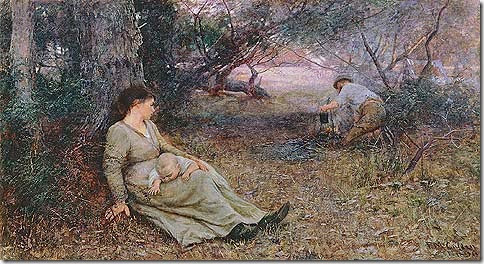The entry on John Dunmore Lang in the Australian Dictionary of Biography describes him variously as Presbyterian clergyman, politician, educationist, immigration organiser, historian, anthropologist, journalist, goal-bird and, in his wife’s words engraved on his statue in Sydney, “Patriot and Statesman.” 
Lang was born in Scotland in 1799, the son of small landowner William Lang and his wife Mary Dunmore. Lang’s mother seems to have had a considerable influence on him. In the words of one of Lang’s biographers, she had formidable powers of moral indignation and such capacity for vituperation that in comparison her son’s most savage strictures seemed but a mild remonstrance!
After qualifying for the ministry, Lang arrived in Sydney in May 1823 as the first Presbyterian minister. There he threw himself into the turbulent religious, political and educational life of the still young colony.
In early 1840, Lang sailed for the US: In travels through eleven states he was deeply impressed by the great merit of republican government based on the independent sovereignty of each state and a large measure of local autonomy. He returned with a new vision for Australia expressed in two books, The Coming Event; or, the United Provinces of Australia (Sydney, 1850) and Freedom and Independence for the Golden Lands of Australia (London, 1852).
This was a time of considerable constitutional change. As part of that change, the original colony of NSW was progressively subdivided with the creation of Van Dieman’s Land (1825), Western Australia (1832), South Australia (1836) and New Zealand (1841).
In June 1843, Lang was elected to represent the Port Phillip District in the NSW Legislative Council in Sydney. There were deep concerns at Port Phillip about remote government from Sydney, about the misuse of revenue raised in Port Phillip on expenditure outside Port Phillip. Further, the District had only six representatives in the Council, too few to make a real impact.
Driven by his vision of a federated Australia with multiple states, Lang threw himself into the self-government cause. This was achieved in 1851 with the creation of Victoria following the passage of the Australian Colonies Act. Lang now turned his attention to Moreton Bay.
The suggestion that a new colony might be formed north of the Manning River if parent colony NSW became too large and unwieldy had first been made by the British Secretary of State in Governor Gipps’ time (1838-1846). A clause in the Constitution Act therefore enabled her Majesty on the petition of inhabitant householders north of the 30th parallel of south latitude to detach such territories from New South Wales and to erect them into a separate colony or colonies. This boundary included the Clarence River, but subdivided the Northern Tablelands, leaving Armidale in NSW.
The stage was now set for a battle that would help set the direction and form the character of the twentieth century campaign for self-government for New England.
Note to readers: This post appeared as a column in the Armidale Express Extra on 16 July 2014, the second in a series telling the story of the Northern or New England self-government moment. I am repeating the columns here with a lag because they are not on line outside subscription. You can see all the Belshaw World and History Revisited columns by clicking here for 2009, here for 2010, here for 2011, here for 2012, here for 2013, here for 2014.
If you want to follow the story of the Northern or New England self-government movement, this is the entry post for the whole series.










